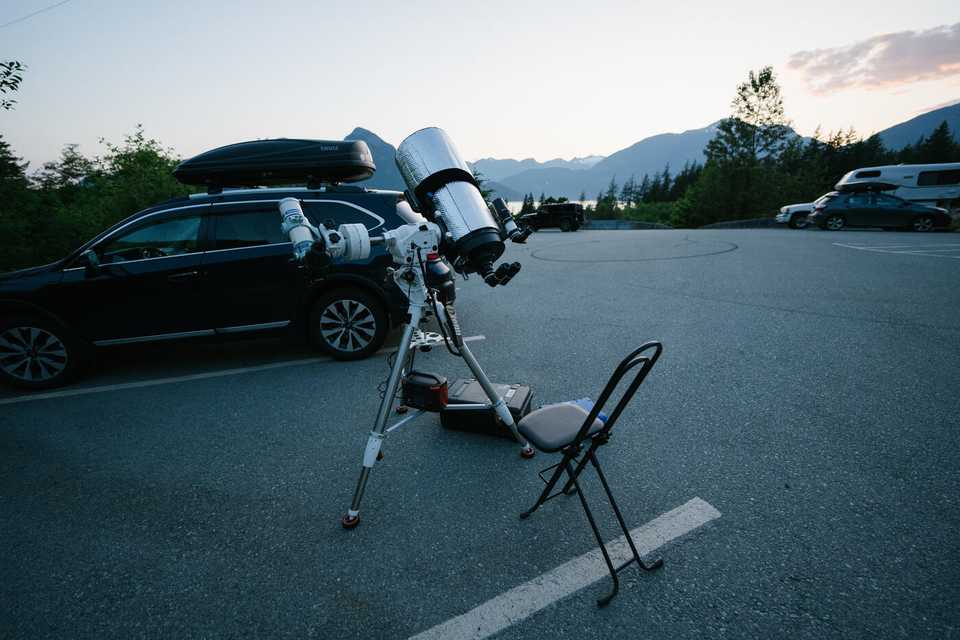Observing the M101 Supernova
The supernova in the Pinwheel Galaxy, M101, was recently discovered on May 19th by Koichi Itagaki, an amateur astronomer from Japan. Coincidentally, just a few days prior, Jeff, Felix, and I had dedicated a significant amount of time to closely examining this galaxy in great detail at Hope Slide, using our 15” and 18” telescopes. As soon as I learned about the supernova, I promptly contacted Felix, who was fortunate enough to observe it the following night while it still appeared relatively dim, possibly around the 14th magnitude. Unfortunately, I couldn’t join him that evening due to other commitments. Furthermore, with the moon steadily rising in the evening sky, approaching its full phase, and June rapidly approaching, I knew that astronomical darkness was not going to be available until July.
Supernovas in other galaxies typically don’t stay bright enough to observe with amateur telescopes for very long, so on Thursday, May 25th, I went up to Porteau Cove knowing full well that the moon was 35% full and wouldn’t be setting until 2 am, making deep sky observing a challenge. Regardless, I hauled my 10” Meade ACF and Takahashi FS-60, along with my Skywatcher AZ-EQ6, out with me and set up around dusk. Scott, an astrophotograher, had his scope (a Celestron Edge 11) and mount (Astrophysics Mach 2), already set up, and we chatted for a while until it started to get dark enough to observe. Threatening clouds started rolling in right around 9:30 pm but thankfully didn’t stick around. Felix also showed up around this time and set up his Takahashi FC-100DL.

The seeing was unfortunately quite atrocious, but I observed the moon with the 10” and my Baader Maxbright II binoviewers with a pair of Tele Vue Panoptic 24mm, which provide the maximum field of view in the 1.25” barrel size. At 104x, the moon showed plenty of detail but the turbulence smeared the detail like the moon was underwater. This effect is made more severe by binoviewing and I started to feel a little nauseous - it speaks to the immersive experience that binoviewing brings!
My friend Adam also joined us and he spent a while observing the moon through this setup, enjoying the view despite the seeing. When it was finally dark enough to observe some deep-sky objects, I toured Adam around some of the greatest hits, like M13, M5, M57, M81/M82, and M51. Later in the night, as Cygnus rose above the mountains, I showed him M27 and the Veil Nebula as well. The views of M13 and M57 were particularly good despite the moonlight, rendering an immersing view of these deep sky objects with the Tele Vue 13mm Nagler and 24mm Panoptics. Globular clusters in particular look great with the binoviewers.
After a while, I slewed my scope over to M101 and could barely make out the faint, diffuse galaxy washed out by moonlight. Without being able to clearly see the spiral arms, confirming the supernova was going to be difficult, although I did notice a bright “star” above the core of the galaxy. Felix confirmed that I was looking at the supernova, and he showed me M101 through his 4” scope (not an easy star-hop!). It was actually easier to spot the supernova through the smaller scope, since there were fewer background stars and the relatively bright supernova was embedded in the faint “nebulousity” of the galaxy. Although the supernova had no distinct shape, looking identical to the other stars in the field of view, seeing it for myself was deeply satisfying, knowing that the light from the exploding star traveled for 21 million years to reach us and thinking about how magnificently bright it must appear for any creature witnessing it from within M101.
Felix and I started feeling tired around 1 am, but knowing that the moon was setting at 2 am, we both took a power nap in our cars and woke up just past moonset for a “power hour” session of deep sky observing. We slewed to the greatest hits again and noted the increased contrast, especially on galaxies. This time the faint spirals of M101 were more apparent, making it easier to pinpoint the location of the supernova. M13 looked even more impressive through the binoviewers, as did M57.
We packed up around 3 AM and drove home, satisfied at having seen the supernova and squeezing in a quick session of deep sky observing after moonset.